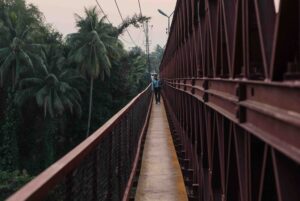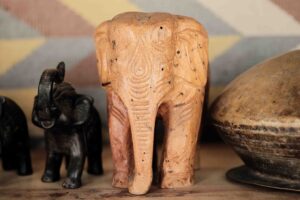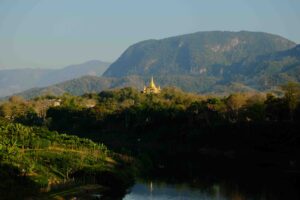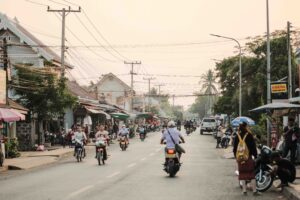ອອກເດີນທາງສູ່ຖະໜົນທີ່ບໍ່ຄຸ້ນເຄີຍ ແລະ ຄົ້ນພົບຫຼວງພະບາງອີກຄັ້ງໜຶ່ງ
ຂົວຂ້າມແມ່ນໍ້າຄານ ເຊິ່ງເປັນໜຶ່ງສະຖານທີ່ທີ່ໂດດເດັ່ນ ແລະ ໜ້າປະທັບໃຈທີ່ສຸດແຫ່ງໜຶ່ງຂອງຫຼວງພະບາງໂດຍກໍາລັງໄດ້ຮັບການປັບປຸງກໍ່ສ້າງຄືນໃໝ່. ຂົວເຫຼັກ ແລະ ໄມ້ອັນເກົ່າແກ່ທີ່ສ້າງຂຶ້ນໃນຊ່ວງປີ 1920 ໂດຍຝຣັ່ງເສດ ເຊິ່ງມາຮອດປັດຈຸບັນ ກໍມີອາຍຸໄດ້ໜຶ່ງຮ້ອຍກວ່າປີແລ້ວ ແລະ ກໍພໍດີເປັນຊ່ວງເວລາທີ່ຫຼວງພະບາງໄດ້ກາຍເປັນສ່ວນໜຶ່ງຂອງອິນດູຈີນ. ຈາກເມື່ອກ່ອນທີ່ຂົວແຫ່ງນີ້ເຄີຍເປັນພຽງທາງຜ່ານສໍາລັບຜູ້ເດີນທາງໄປມາ ແຕ່ກໍຕ້ອງກ້າພະຈົນໄພ ແລະ ກ້າຫານພໍສົມຄວນ ທີ່ຈະສ່ຽງເຂົ້າຢຽບແຜ່ນໄມ້ອັນຂະລຸຂະລະ ແລະ ຄອນແຄນເຊິ່ງຕັ້ງຢູ່ເທິງແມ່ນໍ້າຄານ ໂດຍສະເພາະກໍແມ່ນບໍລິເວນທາງຍ່າງ ແຕ່ມາຮອດຕອນນີ້ແຜ່ນໄມ້ແປ້ນທີ່ສົ່ງສຽງດັງອອດແອດ ແລະ ຜຸຜຸ່ຍທີ່ນອນລຽນລາຍກັນຢູ່ສອງຟາກຂ້າງຂອງຂົວແຫ່ງດັ່ງນີ້ ເຊິ່ງຖືກແທນທີ່ດ້ວຍແຜ່ນເຫຼັກອັນແໜ້ນໜາ. ຂະນະນີ້ທ່ານສາມາດຍ່າງຂ້າມຂົວ ແລະສໍາຫຼວດສິ່ງຕ່າງໆທີ່ຕັ້ງຢູ່ຝັ່ງກົງກັນຂ້າມຂອງແມ່ນໍ້າຄານໄດ້ຢ່າງງ່າຍດາຍ. ແຕ່ຖ້າທ່ານຕ້ອງການເດີນທາງອອກຈາກຕົວເມືອງອັນວຸ້ນວາຍ, ກໍມີກິດຈະກໍາຫຼາຍຢ່າງໃຫ້ເລືອກ ບໍ່ວ່າຈະລົງມືເຮັດດ້ວຍຕົນເອງ ຫຼື ພຽງນັ່ງຊົມໃນບັນຍາກາດທີ່ແຕກຕ່າງກັນ. ແຕ່ຕອນນີ້ພຽງແຕ່ຍ່າງຫຼິ້ນກິນລົມຊົມວິວເທິງຂົວນໍ້າຄານກໍເປັນອັນວ່າສາມາດຊ່ວຍຜ່ອນຄາຍໄດ້ບໍ່ເຊັ່ນກັນ.

ຢູ່ຟາກກົງກັນຂ້າມຂອງແມ່ນໍ້ານັ້ນກໍຈະພາທ່ານເດີນທາງຜ່ານໝູ່ບ້ານທີ່ມີຮ້ານຂາຍເຄື່ອງຂອງຕ່າງໆຫຼາຍຢ່າງ ເປັນຕົ້ນແມ່ນ ກະຕິບເຂົ້າ ແລະ ນໍ້າມັນແອັດຊັງທີ່ບັນຈຸໃສ່ໃນຂວດແກ້ວ, ເວົ້າໄດ້ວ່າ ຊີວິດໃນເຂດນັ້ນແມ່ນຮຽບງ່າຍ ແລະ ແຕກຕ່າງຈາກຊີວິດໃນເມືອງຢ່າງເຫັນໄດ້ຊັດເຈນ, ພ້ອມກັນນັ້ນ ທ່ານຍັງຈະເຫັນຄົນຂາຍກະແລັມພື້ນບ້ານທີ່ຂີ່ລົດຖີບເພື່ອໄປຂາຍໃຫ້ກຸ່ມເດັກນ້ອຍທີ່ກໍາລັງແລ່ນຫຼິ້ນວ່າວຢ່າງມ່ວນຊື່ນ, ອີກຄາວໜຶ່ງກໍຈະເຫັນຄົນເກັບຊື້ເຫຼັກເສດປາກົດຕົວມາພ້ອມກັບລົດຈັກຄູ່ໃຈ ເພື່ອຈະມາຂົນເອົາສັງກະສີແຜ່ນເກົ່າທີ່ເຂົ້າຂີ້ໝ້ຽງແລ້ວ, ເຮືອນຫຼາຍຫຼັງ ຈະມີຖາດບັນຈຸໄຄຄ້າຍຄືເສັ້ນຜົມສີຂຽວທີ່ເກັບມາຈາກນໍ້າຂອງຢັ່ງຢາຍເພື່ອລໍຖ້າໃຫ້ມັນແຫ້ງຕາມພື້ນເຮືອນໄມ້ແບບບ້ານໆ, ແລະ ຍັງຈະເຫັນຫູກຕໍ່າຜ້າແພທີ່ຕັ້ງຕາມຈຸດຂອງລະບຽງເຮືອນຫຼາຍຫຼັງ ພ້ອມກັບສຽງໄກ່ຂັນເປັນແຕ່ລະໄລຍະ.
ຖ້າທ່ານຍ່າງອອກຈາກບ່ອນພັກຕັ້ງແຕ່ຕອນເຊົ້າໆ ທ່ານອາດຈະເຫັນພະສົງສາມະເນນຫຼາຍອົງທີ່ກໍາລັງຍ່າງບິນທະບາດຂ້າມຂົວ ເຊິ່ງເປັນໂອກາດດີທີ່ຈະຈັບກ້ອງຂຶ້ນມາບັນທຶກພາບອັນໜ້າອັດສະຈັນນັ້ນໄວ້. ເຄັດລັບ: ຍັງມີພິທີຕັກບາດນອກເສັ້ນທາງສາຍສໍາຄັນຕ່າງໆຂອງເມືອງຫຼວງພະບາງ. ທ່ານສາມາດພົບເຫັນພະສົງສາມະເນນຍ່າງຕໍ່ແຖວກັນເປັນສາຍຍາວ ເພື່ອຍ່າງບິນທະບາດລຽບຕາມແຄມແມ່ນໍ້າຄານໃນແຕ່ລະວັນ ແລະ ທ່ານອາດຈະແມ່ນຄົນດຽວທີ່ກໍາລັງຢືນເບິ່ງຢູ່. ແຕ່ຖ້າທ່ານຢາກລອງປະສົບການໃໝ່ໃນການໃສ່ບາດແບບຮຽບງ່າຍ ແລະ ງຽບສະຫງົບ, ຂໍແນະນໍາໃຫ້ຂ້າມຂົວແມ່ນໍ້າຄານກ່ອນຕາເວັນຂຶ້ນ ເພື່ອຫຼີກໜີຈາກຝູງຊົນ.

ທີ່ສີ່ແຍກທີສອງພາຍຫຼັງຂຶ້ນຈາກຂົວ, ສາມາດລ້ຽວຊ້າຍເພື່ອທ່ຽວຊົມຕະຫຼາດສົດຂະໜາດນ້ອຍແຕ່ເປັນທີ່ນິຍົມໃນຊຸມຊົນ ເຊິ່ງສະແດງວ່າທ່ານມາຖືກທາງແລ້ວ ເພາະທີ່ນັ້ນມີພືດຜັກນາໆຊະນິດບໍ່ວ່າຈະເປັນໝາກໄມ້, ຜັກສົດ, ເຄື່ອງເທດ, ປາສົດ, ແລະ ຜະລິດຕະພັນເຄື່ອງປ່າຂອງດົງ ເຊັ່ນ ໜໍ່ໄມ້, ສະໝຸນໄພຈາກປ່າທີ່ນໍາມາວາງຂາຍເທິງໂຕະເຕ້ຍ. ທ່ານຍັງສາມາດຊອກຊື້ເຂົ້າ ແລະ ໝາກເຜັດແຫ້ງໄດ້ຫຼາຍປະເພດ ພ້ອມກັບຊິມນໍ້າອ້ອຍສົດໆຈາກຄົນຂາຍ ເພື່ອຫຼຸດຜ່ອນຄວາມຫິວກະຫາຍ ເຊິ່ງຮ້ານນໍ້າອ້ອຍແມ່ນຕັ້ງຢູ່ທາງເຂົ້າຕະຫຼາດເບື້ອງຂວາມື ໂດຍສາມາດແນມເຫັນລໍາອ້ອຍອັນຍາວຢຽດຍື່ນຕົວອອກມາຈາກແຂ້ວເຟືອງໂລຫະຂະໜາດໃຫຍ່ເພື່ອບົດເປັນນໍ້າອ້ອຍສົດ.
ເມື່ອທ່ານເດີນທາງຕາມຖະໜົນທີ່ເຊື່ອມຜ່ານໂຮງແຮມ ດິ ອັບສະລາ ຣີຟ ດຣົວ (The Apsara Rive Droite) ຢ່າລືມສໍາຫຼວດເບິ່ງຊາກສະຫຼັກຫັກພັງຂອງວັດທີ່ຕັ້ງຢູ່ເບື້ອງຂວາມື ເຊິ່ງຊາກສະຫຼັກຫັກພັງດັ່ງກ່າວແມ່ນຊາກທີ່ຫຼົງເຫຼືອຈາກການຮຸກຮານຂອງພວກຫໍ້ ໃນຊ່ວງຊຸມປີ 1880. ເມື່ອສືບຕໍ່ໄປຕາມເສັ້ນທາງສາຍດຽວກັນ ກໍຈະພົບກັບທາງແຍກ ແລ້ວໃຫ້ລ້ຽວຊ້າຍ ແລະ ເມື່ອທ່ານລ້ຽວໂຄ້ງແລ້ວ ກໍຈະເຫັນທີ່ດິນຂະໜາດໃຫຍ່ ໃນນັ້ນຈະມີຈຸດນັ່ງຊົມຕາເວັນຕົກດິນ ເຊິ່ງເປັນຈຸດທີ່ແມ່ນໍ້າຂອງ ແລະ ແມ່ນໍ້າຄານມາບັນຈົບກັນ. ມີທາງຍ່າງເສັ້ນນ້ອຍໆ ລົງໄປຫາໂງ່ນຫີນຂະໜາດໃຫຍ່ ທີ່ຕັ້ງຢູ່ແຄມຝັ່ງແມ່ນໍ້າ. ສະຖານເຫຼົ່ານີ້ ຖືເປັນຈຸດຊົມວິວທີ່ໄດ້ຮັບຄວາມນິຍົມເປັນຢ່າງດີ ສໍາລັບຜູ້ທີ່ຕ້ອງການສໍາຜັດກັບທໍາມະຊາດແບບສ່ວນຕົວ. ທ່ານຈະໄດ້ຊົມທິວທັດອັນສວຍງາມຂອງແມ່ນໍ້າຂອງ ລວມທັງປາກແມ່ນໍ້ານໍາອີກ. ດວງຕາເວັນໃກ້ຈະລັບຂອບຟ້າ ແລະ ເຮືອຫຼາຍລໍາກໍຈະໄດ້ອາບເອ້ແສງອັນອົບອຸ່ນ ເມື່ອຕາເວັນເຄື່ອນຕົວລົງໄປຢູ່ລຸ່ມເສັ້ນຂອບຟ້າຟາກເບື້ອງນັ້ນ.

ຖັດໄປອີກເສັ້ນທາງໜຶ່ງກໍແມ່ນວັດຊຽງເຫຼັກ ເຊິ່ງເປັນຊຸມຊົນທີ່ມີສະເໜ່ ແລະ ຜູ້ຄົນກໍມີຄວາມເປັນກັນເອງ, ວັດແຫ່ງນີ້ມີພະສົງສາມະເນນພຽງສາມອົງເທົ່ານັ້ນ ທີ່ອາໄສຢູ່ໃນວັດຕັ້ງແຕ່ອາຍຸ 14 ປີ ແລະ ໄດ້ຮັບການຂະໜານນາມວ່າ ເປັນຜູ້ເຫັນແຈ້ງແຫ່ງການທໍານາຍໂຊກຊະຕາ. ຖ້າທ່ານສົນໃຈກ່ຽວກັບສະຖາປັດຕະຍະກໍາຂອງວັດ ສາມາດບອກໄດ້ເລີຍວ່າ ການເດີນທາງທ່ອງທ່ຽວມາຍັງສະຖານທີ່ແຫ່ງນີ້ຈະສາມາດຕອບໂຈດໄດ້ຢ່າງໜ້າສົນໃຈ ເນື່ອງຈາກມີວັດວາອາຮາມໃຫ້ທ່ຽວຊົມຫຼາຍສິບແຫ່ງ ທີ່ຕັ້ງຢູ່ໃນບໍລິເວນໃກ້ຄຽງກັນ.
ບ້ານຊ່າງຄ້ອງ ແລະ ບ້ານຊຽງເຫຼັກ ມີຊື່ສຽງໃນນາມໝູ່ບ້ານທີ່ມີອາຊີບຊ່າງຫັດຖະກໍາ, ໂດຍສະເພາະກໍແມ່ນຊື່ສຽງໃນດ້ານການຕໍ່າຫູກທໍໄໝ ແລະ ການຜະລິດເຈ້ຍດ້ວຍປໍສາ, ເມື່ອໄດ້ມາທ່ຽວຊົມໝູ່ບ້ານແຫ່ງນີ້ ທ່ານຈະພົບເຫັນຖາດຫຼາຍໃບທີ່ບັນຈຸປໍສາ ໂຮຍໜ້າດ້ວຍກີບດອກເຈ້ຍສີບົວອ່ອນ ຕາກພື່ງໄວ້ເພື່ອລໍຖ້າໃຫ້ພວກມັນແຫ້ງ, ເຊິ່ງເປັນການຜະລິດເຈ້ຍປໍສາທີ່ມີຊື່ສຽງ. ເນື່ອງຈາກເສັ້ນໃຍຂອງປໍສາມີຄວາມຍາວພໍສົມຄວນ, ຈິ່ງເຮັດໃຫ້ເຈ້ຍມີຄວາມທົນທານໜຽວແໜ້ນ ເຊິ່ງສາມາດນໍາໄປເຮັດໂຄມໄຟ, ປຶ້ມບັນທຶກ, ແລະ ໃຊ້ແຕ້ມຮູບລະບາຍສີເປັນຕົ້ນ. ປະຊາຊົນທ້ອງຖິ່ນອາໄສການທ່ອງທ່ຽວເປັນແຫຼ່ງສ້າງລາຍຮັບໃຫ້ຄອບຄົວ, ເນື່ອງຈາກພວກເຂົາເຈົ້າດໍາລົງຊີວິດຢູ່ເຂດນອກຕົວເມືອງ ຈິ່ງມີຄວາມຫຍຸ້ງຍາກໃນການຫາລ້ຽງຊີບ. ນັກທ່ອງທ່ຽວສາມາດຊອກຊື້ງານແກະສະຫຼັກໄມ້, ເຄື່ອງປະດັບງາມໆ, ແລະ ຜ້າແພທີ່ຜະລິດໃນທ້ອງຖິ່ນ ແລະ ຈໍາໜ່າຍໃນໝູ່ບ້ານນີ້.

ຂາກັບໃນຊ່ວງຕອນບ່າຍ, ຖະໜົນເສັ້ນສຸດທ້າຍກ່ອນຈະມາເຖິງຂົວນໍ້າຄານຈະມີຄວາມຄຶກຄື້ນ ແລະ ຄຶກຄັກເປັນພິເສດໃນຊ່ວງຕອນຄໍ່າ. ທັງສອງຟາກຝັ່ງຈະເຕັມໄປດ້ວຍຮ້ານຂາຍຂອງກິນສຸກ, ລວມທັງຊີ້ນ ແລະ ຜັກສົດ, ມີທັງຂາຍເລກ, ປີ້ງເອັນ, ແລະ ໂລຕີທີ່ລາດໜ້າດ້ວຍນົມຂຸ້ນຫວານເຊິ່ງເຮັດແບບສົດໆໃໝ່ໆວາງຂາຍຢູ່ໜ້າຮ້ານ. ຂົວແຫ່ງນີ້ເຕັມໄປດ້ວຍຜູ້ຄົນໃນທ້ອງຖິ່ນທີ່ພາກັນອອກໄປຂັບລົດຫຼິ້ນ ໃນຂະນະທີ່ອຸນຫະພູມຍາມຄ້ອຍຄໍ່າກໍຄ່ອຍເຢັນລົງ.
ເມື່ອຮອດເວລາຍ່າງກັບຄືນສູ່ຕົວເມືອງຫຼວງພະບາງ, ທ່ານສາມາດໃຊ້ທາງຍ່າງຜ່ານຂົວເບື້ອງຊ້າຍ. ເມື່ອຫັນໜ້າອອກຈາກຕົວເມືອງ ຈະແນມເຫັນວັດປ່າໂພນເພົາ ຮູບຫົກຫຼ່ຽມສີທອງຄໍາ ສ່ອງແສງເຫຼື້ອມລະຍິບລະຍັບເມື່ອຕ້ອງກັບແສງຂອງດວງຕາເວັນທີ່ກຳລັງຈະລັບຂອບຟ້າ ແລະ ຕົ້ນໄມ້ພວມກະຈາຍເງົາສີດໍາລົງໃສ່ແມ່ນ້ຳ. ຊ່ວງເວລານີ້ຖືໄດ້ວ່າເປັນໂອກາດທີ່ດີໃນການຖ່າຍຮູບ ເພື່ອຈະໄດ້ພາບສີທອງແບບແທ້ຈິງ ຍິ່ງເພີ່ມຄວາມຊົງຈໍາກ່ຽວກັບຫຼວງພະບາງໃຫ້ກັບທ່ານໄດ້ຍາວນານຕື່ມຂຶ້ນ.

ການເດີນທາງທ່ຽວຊົມ
ເຂດອ້ອມຮອບຂໍແນະນໍາໃຫ້ເດີນທາງດ້ວຍການຍ່າງ ຫຼື ຂີ່ລົດຖີບປາກເຊ ແລະ ຊຽມລຽບ.
ການເດີນທາງ
ສາຍການບິນລາວໃຫ້ບໍລິການຫຼາຍຖ້ຽວບິນຈາກຫຼວງພະຍາງ ໄປຍັງ ນະຄອນຫຼວງວຽງຈັນ, ບາງກອກ, ຊຽງໃໝ່, ຮ່າໂນ່ຍ, ປາກເຊ ແລະ ຊຽມລຽບ.
ແປ ແລະ ຮຽບຮຽງໂດຍ ໄພບູນ ທະນະບົວສີ
ຮູບໂດຍ Anita Preston / Evensong Film



 English
English
